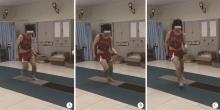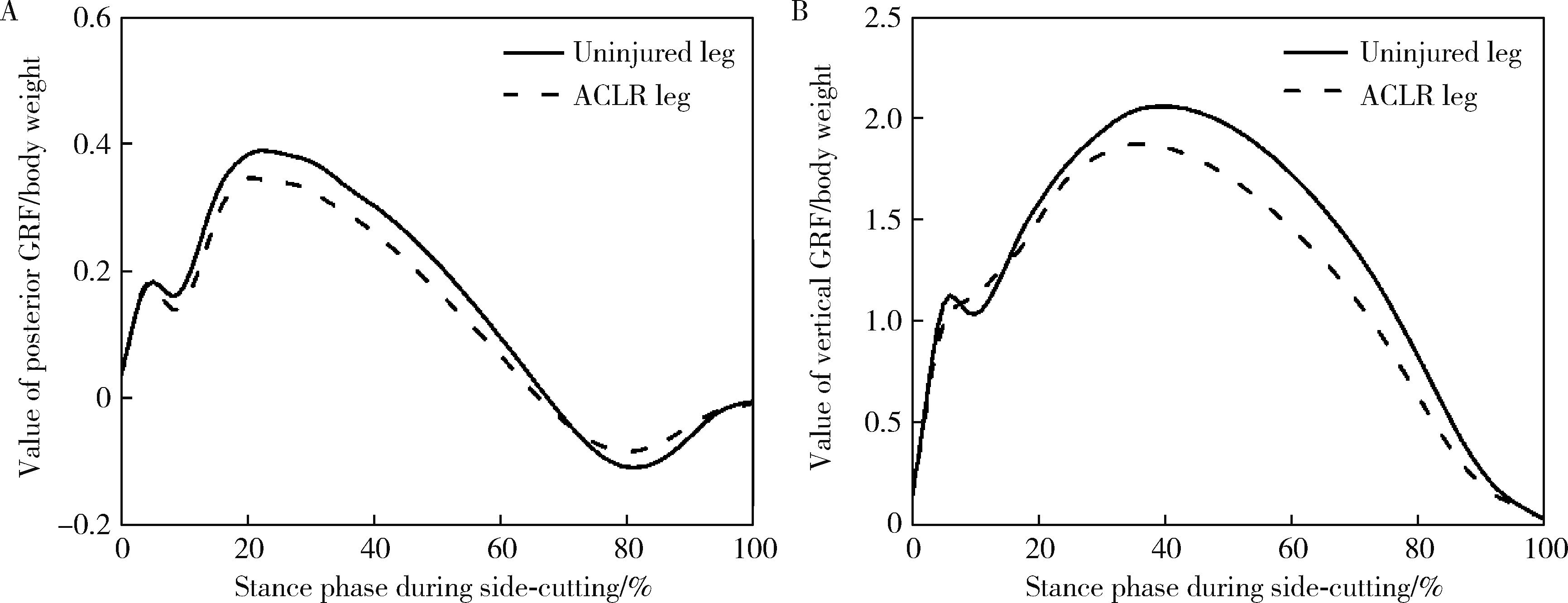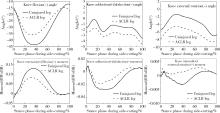Journal of Peking University (Health Sciences) ›› 2024, Vol. 56 ›› Issue (5): 868-873. doi: 10.19723/j.issn.1671-167X.2024.05.018
Previous Articles Next Articles
Biomechanics during cutting movement in individuals after anterior cruciate ligament reconstruction
Shuang REN, Huijuan SHI, Zixuan LIANG, Si ZHANG, Xiaoqing HU, Hongshi HUANG*( ), Yingfang AO*(
), Yingfang AO*( )
)
- Department of Sports Medicine, Peking University Third Hospital; Institute of Sports Medicine of Peking University; Beijing Key Laboratory of Sports Injuries; Engineering Research Center of Sports Trauma Treatment Technology and Devices, Ministry of Education, Beijing 100191, China
CLC Number:
- R686.5
| 1 |
Ardern CL , Taylor NF , Feller JA , et al. Fifty-five per cent return to competitive sport following anterior cruciate ligament reconstruction surgery: An updated systematic review and meta-analysis including aspects of physical functioning and contextual factors[J]. Br J Sports Med, 2014, 48 (21): 1543- 1552.
doi: 10.1136/bjsports-2013-093398 |
| 2 |
Wiggins AJ , Grandhi RK , Schneider DK , et al. Risk of secondary injury in younger athletes after anterior cruciate ligament reconstruction: A systematic review and meta-analysis[J]. Am J Sports Med, 2016, 44 (7): 1861- 1876.
doi: 10.1177/0363546515621554 |
| 3 |
Johnston JT , Mandelbaum BR , Schub D , et al. Video analysis of anterior cruciate ligament tears in professional american football athletes[J]. Am J Sports Med, 2018, 46 (4): 862- 868.
doi: 10.1177/0363546518756328 |
| 4 | Kobayashi H , Kanamura T , Koshida S , et al. Mechanisms of the anterior cruciate ligament injury in sports activities: A twenty-year clinical research of 1 700 athletes[J]. J Sports Sci Med, 2010, 9 (4): 669- 675. |
| 5 |
Yang C , Yao W , Garrett WE , et al. Effects of an intervention program on lower extremity biomechanics in stop-jump and side-cutting tasks[J]. Am J Sports Med, 2018, 46 (12): 3014- 3022.
doi: 10.1177/0363546518793393 |
| 6 |
Arundale AJH , Silvers-Granelli HJ , Marmon A , et al. Changes in biomechanical knee injury risk factors across two collegiate soccer seasons using the 11+ prevention program[J]. Scand J Med Sci Sports, 2018, 28 (12): 2592- 2603.
doi: 10.1111/sms.13278 |
| 7 |
Dai B , Garrett WE , Gross MT , et al. The effects of 2 landing techniques on knee kinematics, kinetics, and performance during stop-jump and side-cutting tasks[J]. Am J Sports Med, 2015, 43 (2): 466- 474.
doi: 10.1177/0363546514555322 |
| 8 |
Hughes G , Musco P , Caine S , et al. Lower limb asymmetry after anterior cruciate ligament reconstruction in adolescent athletes: A systematic review and meta-analysis[J]. J Athl Train, 2020, 55 (8): 811- 825.
doi: 10.4085/1062-6050-0244-19 |
| 9 |
Sharafoddin-Shirazi F , Letafatkar A , Hogg J , et al. Biomechanical asymmetries persist after ACL reconstruction: Results of a 2-year study[J]. J Exp Orthop, 2020, 7 (1): 86.
doi: 10.1186/s40634-020-00301-2 |
| 10 | 李翰君, 刘卉, 张美珍, 等. 确定前交叉韧带损伤概率及危险因素的随机生物力学模型与模拟[J]. 体育科学, 2014, 34 (12): 37- 43. |
| 11 |
Burland JP , Toonstra JL , Howard JS . Psychosocial barriers after anterior cruciate ligament reconstruction: A clinical review of factors influencing postoperative success[J]. Sports Health, 2019, 11 (6): 528- 534.
doi: 10.1177/1941738119869333 |
| 12 | Gokeler A , Hof AL , Arnold MP , et al. Abnormal landing strategies after ACL reconstruction[J]. Scand J Med Sci Sports, 2010, 20 (1): e12- e19. |
| 13 |
Dai B , Butler RJ , Garrett WE , et al. Anterior cruciate ligament reconstruction in adolescent patients: Limb asymmetry and functional knee bracing[J]. Am J Sports Med, 2012, 40 (12): 2756- 2763.
doi: 10.1177/0363546512460837 |
| 14 |
Nunley RM , Wright D , Renner JB , et al. Gender comparison of patellar tendon tibial shaft angle with weight bearing[J]. Res Sports Med, 2003, 11 (3): 173- 185.
doi: 10.1080/15438620390231193 |
| 15 |
Yu B , Lin CF , Garrett WE . Lower extremity biomechanics during the landing of a stop-jump task[J]. Clin Biomech (Bristol, Avon), 2006, 21 (3): 297- 305.
doi: 10.1016/j.clinbiomech.2005.11.003 |
| 16 |
Li G , Papannagari R , de Frate LE , et al. Comparison of the ACL and ACL graft forces before and after ACL reconstruction: An in vitro robotic investigation[J]. Acta Orthop, 2006, 77 (2): 267- 274.
doi: 10.1080/17453670610046019 |
| 17 |
Woo SL , Hollis JM , Adams DJ , et al. Tensile properties of the human femur-anterior cruciate ligament-tibia complex. The effects of specimen age and orientation[J]. Am J Sports Med, 1991, 19 (3): 217- 225.
doi: 10.1177/036354659101900303 |
| 18 |
Scanlan SF , Chaudhari AM , Dyrby CO , et al. Differences in tibial rotation during walking in ACL reconstructed and healthy contralateral knees[J]. J Biomech, 2010, 43 (9): 1817- 1822.
doi: 10.1016/j.jbiomech.2010.02.010 |
| 19 |
Pairot-de-Fontenay B , Willy RW , Elias ARC , et al. Running biomechanics in individuals with anterior cruciate ligament reconstruction: A systematic review[J]. Sports Med, 2019, 49 (9): 1411- 1424.
doi: 10.1007/s40279-019-01120-x |
| 20 | Karanikas K , Arampatzis A , Brüggemann GP . Motor task and muscle strength followed different adaptation patterns after anterior cruciate ligament reconstruction[J]. Eur J Phys Rehabil Med, 2009, 45 (1): 37- 45. |
| 21 |
Perraton LG , Hall M , Clark RA , et al. Poor knee function after ACL reconstruction is associated with attenuated landing force and knee flexion moment during running[J]. Knee Surg Sports Traumatol Arthrosc, 2018, 26 (2): 391- 398.
doi: 10.1007/s00167-017-4810-5 |
| 22 | Arhos EK , Capin JJ , Buchanan TS , et al. Quadriceps strength symmetry does not modify gait mechanics after anterior cruciate ligament reconstruction, rehabilitation, and return-to-sport training[J]. Am J Sports Med, 2020, 49 (2): 417- 425. |
| 23 |
King E , Richter C , Franklyn-Miller A , et al. Biomechanical but not timed performance asymmetries persist between limbs 9 months after ACL reconstruction during planned and unplanned change of direction[J]. J Biomech, 2018, 81, 93- 103.
doi: 10.1016/j.jbiomech.2018.09.021 |
| [1] | Jiangjing WANG,Shunyi WEI,Yingfang AO,Yuping YANG. Comparison of the early analgesic efficacy of three different drugs after anterior cruciate ligament reconstruction [J]. Journal of Peking University (Health Sciences), 2024, 56(2): 293-298. |
| [2] | Han ZHAO,Yan WEI,Xuehui ZHANG,Xiaoping YANG,Qing CAI,Chengyun NING,Mingming XU,Wenwen LIU,Ying HUANG,Ying HE,Yaru GUO,Shengjie JIANG,Yunyang BAI,Yujia WU,Yusi GUO,Xiaona ZHENG,Wenjing LI,Xuliang DENG. Bionic design, preparation and clinical translation of oral hard tissue restorative materials [J]. Journal of Peking University (Health Sciences), 2024, 56(1): 4-8. |
| [3] | Yu YIN,Yu MEI,Ze-gang WANG,Shou-yi SONG,Peng-fei LIU,Peng-feng HE,Wen-jie WU,Xing XIE. Lengths of the fixed loop and the adjustable loop in the coarse bone tunnel were compared to influence the widening of the femoral bone tunnel and the function of the knee joint [J]. Journal of Peking University (Health Sciences), 2021, 53(5): 883-890. |
| [4] | Shuang REN,Hui-juan SHI,Jia-hao ZHANG,Zhen-long LIU,Jia-yi SHAO,Jing-xian ZHU,Xiao-qing HU,Hong-shi HUANG,Ying-fang AO. Finite element analysis of the graft stresses after anterior cruciate ligament reconstruction [J]. Journal of Peking University (Health Sciences), 2021, 53(5): 865-870. |
| [5] | Yan-fang JIANG,Jian WANG,Yong-jian WANG,Jia LIU,Yin PEI,Xiao-peng LIU,Ying-fang AO,Yong MA. Mid-to-long term clinical outcomes and predictors after anterior cruciate ligament revision [J]. Journal of Peking University (Health Sciences), 2021, 53(5): 857-863. |
| [6] | Yuan WU,Xiao-li LI,Song-lin YANG,Xiao-ming YAN,Hai-li LI. Examination and discriminant analysis of corneal biomechanics with CorVis ST in keratoconus and subclinical keratoconus [J]. Journal of Peking University(Health Sciences), 2019, 51(5): 881-886. |
| [7] | Chao WU,Zhen-yu WANG,Guo-zhong LIN,Tao YU,Bin LIU,Yu SI,Yi-bo ZHANG,Yuan-chao LI. Biomechanical changes of sheep cervical spine after unilateral hemilaminectomy and different degrees of facetectomy [J]. Journal of Peking University(Health Sciences), 2019, 51(4): 728-732. |
| [8] | RONG Yan-bo, TIAN Guang-lei, CHEN Shan-lin. Biomechanical analysis of the deep radioulnar ligaments stabilizing the distal radioulnar joint [J]. Journal of Peking University(Health Sciences), 2017, 49(3): 518-521. |
|
||





